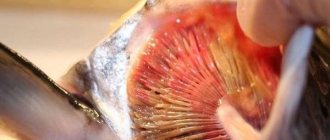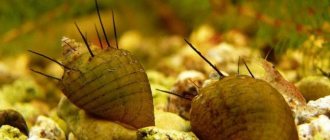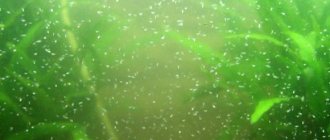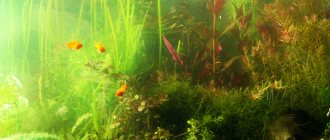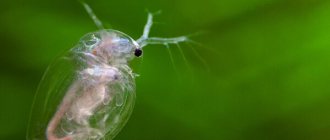Lesson No. 5 on the topic “What determines the color of fish? Part 1. Ocean life. "Secrets of living nature"
Development of activities and quizzes “Secrets of living nature”
Many secrets and mysteries of nature still remain unsolved, but every year scientists discover more and more new species of previously unknown animals and plants.
Thus, snail worms were recently discovered, the ancestors of which lived on Earth over 500 million years ago; Scientists also managed to catch a fish that was previously thought to have gone extinct 70 million years ago.
This material is dedicated to the extraordinary, mysterious and as yet inexplicable phenomena of ocean life. Learn to understand the complex and diverse relationships between the inhabitants of the ocean, many of which have lived in its depths for millions of years.
Type of lesson:
Generalization and systematization of knowledge
Target:
development of erudition, cognitive and creative abilities of students; developing the ability to search for information to answer questions.
Tasks:
Educational
: the formation of cognitive culture, mastered in the process of educational activities, and aesthetic culture as the ability to have an emotional and value-based attitude towards objects of living nature.
Educational:
development of cognitive motives aimed at obtaining new knowledge about living nature; cognitive qualities of a person associated with mastering the fundamentals of scientific knowledge, mastering methods of studying nature, and developing intellectual skills;
Educational:
orientation in the system of moral norms and values: recognition of the high value of life in all its manifestations, the health of one’s own and other people; environmental awareness; nurturing love for nature;
UUD
Personal
: understanding of responsibility for the quality of acquired knowledge; understanding the value of adequately assessing one’s own achievements and capabilities;
Cognitive
: ability to analyze and evaluate the impact of environmental factors, risk factors on health, the consequences of human activities in ecosystems, the impact of one’s own actions on living organisms and ecosystems; focus on continuous development and self-development; the ability to work with various sources of information, convert it from one form to another, compare and analyze information, draw conclusions, prepare messages and presentations.
Regulatory:
the ability to organize independent completion of tasks, evaluate the correctness of work, and reflect on one’s activities.
Communicative:
the formation of communicative competence in communication and cooperation with peers, understanding the characteristics of gender socialization in adolescence, socially useful, educational, research, creative and other types of activities.
Technologies:
Health conservation, problem-based, developmental education, group activities
Lesson structure
:
Conversation - reasoning about previously acquired knowledge on a given topic,
Watching video material (film),
Topic
: “ What determines the color of fish?”
“
What determines the color of fish?”
Presentation “What determines the color of fish”
Presentation “What determines the color of fish” PPTX / 9.95 Mb
Sea creatures are among the most brightly colored creatures in the world.
Such organisms, shimmering with all the colors of the rainbow, live in the sun-pierced waters of warm tropical seas.
Coloring of fish, its biological significance.
Coloration has important biological significance for fish. There are protective and warning colors. The protective coloration is intended to camouflage the fish against the background of the environment. Warning, or sematic, coloration usually consists of conspicuous large, contrasting spots or stripes with clear boundaries. It is intended, for example, in poisonous and venom-bearing fish, to prevent a predator from attacking them and in this case is called deterrent.
Identification coloring
used to warn a rival in territorial fish, or to attract females to males, warning them that the males are ready to spawn. The last type of warning coloration is usually called the mating plumage of fish. Often the identifying coloration unmasks the fish. It is for this reason that in many fish guarding their territory or their offspring, the identification coloration in the form of a bright red spot is located on the belly, is demonstrated to the opponent if necessary and does not interfere with the camouflage of the fish when its belly is located towards the bottom. There is also pseudosematic coloration, which imitates the warning coloration of another species. It is also called mimicry. It allows harmless fish species to avoid attack by a predator that mistakes them for a dangerous species.
What determines the color of fish?
The color of fish can be surprisingly varied, but all possible shades of their color are due to the work of special cells called chromatophores. They are found in a specific layer of the fish's skin and contain several types of pigments. Chromatophores are divided into several types.
Firstly, these are melanophores
containing a black pigment called melanin. Further, ethytrophores, containing red pigment, and xanthophores, in which it is yellow. The latter type is sometimes called lipophores because the carotenoids that make up the pigment in these cells are dissolved in lipids. Guanophores or iridocytes contain guanine, which gives fish a silvery color and a metallic sheen. The pigments contained in chromatophores differ chemically in stability, solubility in water, sensitivity to air and some other characteristics. The chromatophores themselves are also not the same in shape - they can be either star-shaped or round. Many colors in the coloration of fish are obtained by superimposing one chromatophore on another; this possibility is ensured by the occurrence of cells in the skin at different depths. For example, green color is obtained when deep-lying guanophores are combined with covering xanthophores and erythrophores. If you add melanophores, the fish's body turns blue.
Chromatophores do not have nerve endings, with the exception of melanophores. They are even involved in two systems at once, having both sympathetic and parasympathetic innervation. The remaining types of pigment cells are controlled humorally.
The color of fish is quite important for their life.
. The functions of coloring are divided into protective and warning. The first option is designed to camouflage the fish’s body in the environment, so this color usually consists of calm colors. Warning coloring, on the contrary, includes a large number of bright spots and contrasting colors. Its functions are different. In poisonous predators, who usually say with the brightness of their body: “Don’t come near me!”, it plays a deterrent role. Territorial fish, guarding their home, are brightly colored to warn rivals that the site is occupied and to attract a mate. A type of warning coloration is also the mating plumage of fish.
Depending on the habitat, the body color of the fish acquires characteristic features that make it possible to distinguish pelagic, bottom, thicket and school colors.
Thus, the color of fish depends on many factors, including habitat, lifestyle and diet, time of year and even the mood of the fish.
Identification coloring
In the teeming waters around the coral reefs, each species of fish has its own identifying paint, like the uniforms of football players on a team.
. This allows other fish and individuals of the same species to instantly recognize it.
The blenny's coloration becomes brighter as it seeks to attract a mate.
The dogfish is a deadly predator
The dogfish belongs to the order of rock-toothed or pufferfish, and there are more than ninety species of them. It differs from other fish in its unique ability to swell when frightened, swallowing a large volume of water or air. Then it pricks itself with its spines, releasing a nerve poison called tetrodotoxin, which is 1200 times more potent than potassium cyanide.
The dog-fish, due to the special structure of its teeth, received the name rock-toothed. Fugu's teeth are very strong, fused together, and look like four plates. With their help, she splits shells of mollusks and shells of crabs, obtaining food. There is a rare case when a still living fish, not wanting to be eaten, bit off the cook’s finger. Some types of fish are also capable of biting, but the main danger is their meat. In Japan, this exotic fish is called fugu; when skillfully prepared, it ranks first on the list of delicacies of local cuisine. The price for one serving of this dish reaches $750. When an amateur cook takes on its preparation, the tasting ends in death, since the skin and internal organs of this fish contain strong poison. First, the tip of the tongue goes numb, then the limbs, followed by convulsions and instant death. When gutting the fish, the dog emits a fetid, terrible odor.
The coloring of the Moorish Idol fish appears most vibrant when it is hunting its prey.
The main body color is white. The edge of the upper jaw is black. The lower jaw is almost completely black. At the top of the muzzle there is a bright orange spot with a black border. There is a wide black stripe between the first dorsal fin and the ventral fin. Two thin, curved bluish stripes extend from the first black stripe, from the beginning of the ventral fins to the front of the dorsal fin, and from the ventral cavity to the base of the dorsal fin. The third, less noticeable, bluish stripe is located from the eyes towards the back. The second, gradually expanding, wide black stripe is located from the dorsal rays in the direction of the ventral ones. Behind the second wide black stripe there is a thin vertical white line. A bright yellow-orange spot with a thin white edge extends from the tail to the middle of the body, where it gradually merges with the main white color. The caudal fin is black with a white edge.
Day and night coloring
At night, the fusilier fish sleeps on the seabed, taking on a dark color that matches the color of the sea depths and bottom. Waking up, it brightens and becomes completely light as it approaches the surface. By changing color, it becomes less noticeable.
Awake fish
Waking up fish
sleeping fish
Warning coloring
Seeing from afar a brightly colored harlequin toothfish fish
", other fish immediately understand that this hunting area is already occupied.
Warning coloring
The bright color warns the predator: beware, this creature has an unpleasant taste or is poisonous! Sharpnose pufferfish
extremely poisonous, and other fish do not touch it. In Japan, this fish is considered edible, but when cutting it, an experienced expert must be present to remove the poison and make the meat harmless. Yet this fish, called fugu and considered a delicacy, claims the lives of many people every year. So, in 1963, 82 people were poisoned by viper fish meat and died.
The puffer fish is not at all scary in appearance: it is only the size of a palm, swims tail first, very slowly. Instead of scales there is thin elastic skin, capable of swelling in case of danger to a size three times larger than the original one - a kind of goggle-eyed, outwardly harmless ball.
However, the liver, skin, intestines, caviar, milt and even its eyes contain tetrodoxin, a strong nerve poison, 1 mg of which is a lethal dose for humans. There is no effective antidote for it yet, although the poison itself, in microscopic doses, is used to prevent age-related diseases, as well as to treat prostate diseases.
Multicolor mystery
Most starfish move very slowly and live on a clean bottom, not hiding from enemies. Faded, muted tones would better help them become invisible, and it is very strange that the stars are so brightly colored.
Depending on the habitat, the body color of the fish acquires characteristic features that make it possible to distinguish pelagic, bottom, thicket and school colors
.
Pelagic fish
The term "pelagic fish" comes from the location in which they live. This zone is the area of the sea or ocean
which does not border the bottom surface. Pelageal - what is it? From Greek, “pelagial” is interpreted as “open sea”, which serves as a habitat for nekton, plankton and pleiston. Conventionally, the pelagic zone is divided into several layers: epipelagic - located at a depth of up to 200 meters; mesopelagic - at a depth of up to 1000 meters; bathypelagic - up to 4000 meters; above 4000 meters - abisopelagic.
Popular types
The main commercial fish catch is pelagics. It accounts for 65-75% of the total catch. Due to large natural reserves and availability, pelagic fish are the most inexpensive type of seafood. However, this does not in any way affect the taste and usefulness. The leading position in the commercial catch is occupied by pelagic fish of the Black Sea, the North Sea, the Marmara Sea, the Baltic Sea, as well as the North Atlantic and Pacific seas. These include smelt (capelin), anchovy, herring, herring, horse mackerel, cod (blue whiting), and mackerel.
Bottom fish
— most of the life cycle is spent at the bottom or in close proximity to the bottom. They are found both in coastal areas of the continental shelf and in the open ocean along the continental slope.
Bottom-dwelling fish can be divided into two main types: purely bottom-dwelling and benthopelagic, which rise above the bottom and swim in the water column. In addition to the flattened body shape, an adaptive feature of the structure of many bottom-dwelling fish is the lower mouth, which allows them to feed from the ground. Sand sucked in with food is usually expelled through the gill slits.
Overgrown color
Overgrown color
- brownish, greenish or yellowish back and usually transverse stripes or streaks on the sides. This coloring is characteristic of fish from thickets or coral reefs. Sometimes these fish, especially in the tropical zone, can be quite brightly colored.
Examples of fish with thicket coloration include: common perch and pike - from freshwater forms; scorpionfish, many wrasses and coral fish are from the sea.
Vegetation, as an element of the landscape, is also important for adult fish. Many fish are specially adapted to life in thickets. They have a corresponding protective coloring. or a special body shape, reminiscent of the fish among which the fish lives. Thus, the long outgrowths of the fins of the rag-tailed seahorse, in combination with the appropriate coloring, make it completely invisible among the underwater thickets
.
flocking color
A number of structural features, in particular the coloring of fish, are also associated with a schooling lifestyle. Schooling coloring helps fish orient themselves towards each other. In those fish in which a schooling lifestyle is characteristic only of juveniles, accordingly, a schooling coloration can appear.
A moving flock is different in shape from a stationary one, which is due to the provision of favorable hydrodynamic conditions for movement and orientation. The shape of a moving and stationary school differs in different species of fish, and can also be different in the same species. A moving fish forms a certain force field around its body. Therefore, when moving in a school, fish adapt to each other in a certain way. Schools are usually grouped from fish of similar sizes and similar biological conditions. Fish in a school, unlike many mammals and birds, apparently do not have a permanent leader, and they alternately focus on one or another of their members, or, more often, on several fish at once. Fish navigate in a school using, first of all, the organs of vision and the lateral line.
Mimicry
One type of adaptation is color change. Flat fish are masters of such a miracle: they can change color and its pattern in accordance with the pattern and color of the seabed
. Swimming along the bottom, which is familiar to them, they change their color in just a few seconds. It takes them longer to adjust to an unfamiliar bottom, but experiments show that flat fish can even adapt to a checkerboard-shaped bottom.
Flounder acquires a variety of spotted colors
swimming on the rocky bottom. This allows her to hide from predators.
Zoo ABC. Red sea fish
The fish changed color
The goldfish has changed color!!!
Resources:
Rick Morris "Secrets of Wildlife"
Briefly about everything © https://kratkoe.com/kak-zimuet-kunitsa/
Educational portal
https://cleverpenguin.ru/metabolizm-kletki
School world INFO https://www.shkolnymir.info/content/view/95/9
Nature of the world
https://natworld.info/novosti/babochki-mogut-byt-starshe-cvetov-na-desjatki-millionov-let
FB.ru
https://fb.ru/article/198783/hvostatyie-zemnovodnyie-samyie-yarkie-predstaviteli etogo-otryada
Biolessons
https://biouroki.ru/material/lab/2.html
YouTube website
: https://www.youtube.com/
Presentation hosting
— https://ppt4web.ru/nachalnaja-shkola/prezentacija-k-uroku-okruzhajushhego-mira-vo-klasse-chto-takoe-ehkonomika.html
Links[edit]
- Sugimoto, Masazumi (2002). "Morphological color changes in fish: regulation of pigment cell density and morphology". Microscopic Research and Technique
.
58
(6):496–503. DOI: 10.1002/jemt.10168. ISSN 1097-0029. PMID 12242707. - ^ a b c d e f g h i j k Fish diversity: biology, evolution, ecology
. Helfman, Jean S., Helfman, Jean S. (2nd ed.). Chichester, UK: Blackwell. 2009. ISBN. 978-1-4051-2494-2. OCLC 233283748 .CS1 maint: others (link) - Endler, John A. (1978), Hecht, Max K.; Steere, William S.; Wallace, Bruce (ed.), Predator View Colored Animal Patterns
, Evolutionary Biology, Springer USA, pp. 319-364. : 10.1007/978-1-4615-6956-5_5, ISBN 978-1-4615-6956-5 - ^ a b c
"The Meaning of Coral Reef Fish Colors and Patterns: A Review".
ReefCI
. Retrieved April 28, 2021. - ^ a b c
Price, Anna;
Weadick, Cameron; Shim, Janet; Rodd, Frida (01/01/2009). "Pigments, patterns and behavior of fishes". Danio
.
5
(4): 297–307. DOI: 10.1089/zeb.2008.0551. PMID 19133828. - Nüsslein-Volhard, Christiane; Singh, Ajit Pratap (2017). "How fish color their skin: a paradigm for the development and evolution of adult patterns". BioEssays
.
39
(3): 1600231. DOI: 10.1002/bies.201600231. ISSN 1521-1878. PMID 28176337. - Ullman, Eileen; Tuncher, Sezginer; Kizilkaya, Inci Tuney; Zilifli, Aytukh; Alford, Polly; Jovos, Ioannis (04/01/2020). "The spread of lionfish in the Aegean Sea in Turkey: a looming potential environmental disaster." Regional Studies in Marine Sciences
.
36
: 101271. doi: 10.1016/j.rsma.2020.101271. ISSN 2352-4855. - ^ a b c d e f g
Randall, John E. (April 3, 2005).
"Review of Mimicry in Marine Fishes" (PDF). Zoological Research
.
44
(3):299–328. - Parichi, David M (December 2003). "Pigment patterns: fish in stripes and spots." Current Biology
.
13
(24): R947 – R950. DOI: 10.1016/j.cub.2003.11.038. PMID 14680649. - ^ a b
Barlow, George W. (1972-03-08).
"The Relation of Fish-Eye Lines to Body Shape, Stripes, and Stripes." Kopeya
.
1972
(1):4–12. DOI: 10.2307/1442777. JSTOR 1442777. - ^ a b c d
Sugimoto, Masazumi (2002).
"Morphological color changes in fish: regulation of pigment cell density and morphology". Microscopic Research and Technique
.
58
(6):496–503. DOI: 10.1002/jemt.10168. ISSN 1097-0029. PMID 12242707. - ^ a b
Heflin, B.;
Young, L.; Londraville, R.L. (2009). "Short-term changes in skin coloration in the black-spotted montane raptor Entomacrodus striatus." Journal of Fish Biology
.
74
(7):1635–1641. DOI: 10.1111/j.1095-8649.2009.02200.x. ISSN 1095-8649. PMID 20735660. - Henning, Frederico; Renz, Adina Josepha; Fukamachi, Shoji; Meyer, Axel (May 2010). "Genetic, comparative genomic and expression analysis of the Mc1r locus in the polychrome fish species group Midas Cichlid (Teleostei, Cichlidae Amphilophus sp.)". Journal of Molecular Evolution
.
70
(5): 405–412. Bibcode: 2010JMolE..70..405H. DOI: 10.1007/s00239-010-9340-4. ISSN 0022-2844. PMID 20449580. - ^ a b
Sköld, Helen Nilsson;
Aspengren, Sarah; Wallin, Margareta (2013). "Rapid color change in fish and amphibians—functions, regulation, and new applications." Research on pigment cells and melanoma
.
26
(1): 29–38. DOI: 10.1111/pcmr.12040. ISSN 1755-148X. PMID 23082932. - Henning, Frederico; Jones, Julia S.; Franchini, Paolo; Meyer, Axel (13 March 2013). "Transcriptomics of morphological color variation in polychromatic Midas cichlids". BMC Genomics
.
14
(1): 171. DOI: 10.1186/1471-2164-14-171. ISSN 1471-2164. PMC 3623868. PMID 23497064. - Pastana, Minnesota; Dagosta, FTP; Esguisero, A. L. H. (2017). "A new sexually dichromatic miniature Hyphessobrycon (Teleostei: Characiformes: Characidae) from the Rio Formiga, upper Rio Juruena basin, Mato Grosso, Brazil, with a review of sexual dichromatism in the characters." Journal of Fish Biology
.
91
(5):1301–1318. DOI: 10.1111/jfb.13449. ISSN 1095-8649. PMID 28905382.
Peekaboo
Light can have a positive or negative effect on fish. After hatching, many fry react negatively to light and immediately turn to darkness while their eyes undergo further development. After the completion of the anatomical and functional development of the eyes, which usually ends several hours after hatching, the fry seek light and begin to actively feed. The level of illumination and the nature of shelters in the general habitat determine whether the fish need to look for shelter or can swim openly around the aquarium, and the time of day when they can feed.
The changes are amazing. The fry of many viviparous and cyprinodonts are born or hatch from eggs already fully formed and respond positively to light, immediately starting to feed on brine shrimp nauplii (or natural zooplankton), but they need light to see their prey. Other fry hatch as prelarvae, not fully formed, and they often react negatively to light, looking for dark places where they can hide and develop until they are able to swim and feed normally.
Guppy (Poecilia r eticulata) is a viviparous fish. (Photo by Davide Farina)
Light can have a destructive effect, interfere with the normal development of eyes or other organs, or simply help predators discover the fry just when they are not yet able to escape. The hatching of the fry of many species of marine fish occurs at night, whereas in the light the hatching sequence of the fry is blocked.
The hatching of fry in other fish does not depend on light. Light affects eye and swim bladder development, releases a hatching enzyme (chorion) that dissolves the inner walls of the eggs - and can even stimulate the growth of toxic algae that kills the eggs or fry.
Photosensitivity of eggs and fry
What lamp combination is best for aquarium fish? Light affects the entire feeding period and natural growth rates. Controlling light intensity and photoperiods is used in aquaculture to stimulate spawning in adult fish and accelerate growth rates in their offspring. To stimulate spawning, light is used much more often than hormonal injections. It is safer, more predictable, cheaper and does not require special training.
In the accompanying section of our online store you can purchase:
Everything for lighting
Submersible luminaires
LED lamps
Lamps
Many fish eggs die due to exposure to light. Neon eggs must be incubated in the dark or they will never hatch. Angelfish eggs develop best when incubated in water darkened with methylene blue—an otherwise inactive substance. Aquarists often report infertile eggs from discus, angelfish or other South American cichlids (the eggs are 100% dead), but it is possible that this death is due to the fertilized eggs being exposed to light from which they are unable to recover. Sometimes damage to eggs is caused by algae, which release toxins when exposed to light.
Neon (Paracheirodon innesi). (Photo by Sihan Kilik)
High-energy ultraviolet light damages DNA by breaking molecular bonds. Many cells produce an enzyme that repairs the DNA molecule, but this enzyme must work quickly (within 20 minutes) or the damage cannot be repaired. It is often the case that either the eggs of neons (or other fish) are sensitive to low levels of ultraviolet radiation (or other types of intense radiation), or we fail to find a stimulus for the self-repair mechanisms, and thus the DNA remains damaged and the fertilized eggs dies.
Many enzymes are stimulated or blocked by light. What is a self-healing mechanism? For bacteria injured by ultraviolet radiation, this is bright daylight. If neon is like bacteria, then the cure for UV injury is a sudden bright light within minutes of spawning. If you have reason to suspect that a spawning pair of fish is infertile, try incubating the eggs in complete darkness. If that doesn't work, try exposing her to strong, bright light for a few minutes after she's finished spawning.
Animal carotenoids
Astaxanthin is produced naturally from crustaceans, particularly Atlantic krill (Euphausia superba), crayfish meal, shrimp and crayfish. These are rich sources of astaxanthin, which are actively used in fish farming. However, the possibility of obtaining carotenoids of animal origin is limited because there is a decreasing trend in the catch of crustaceans (shrimp, crabs, crayfish). In addition, this source is very expensive and too costly for aquarists.

